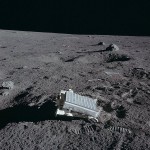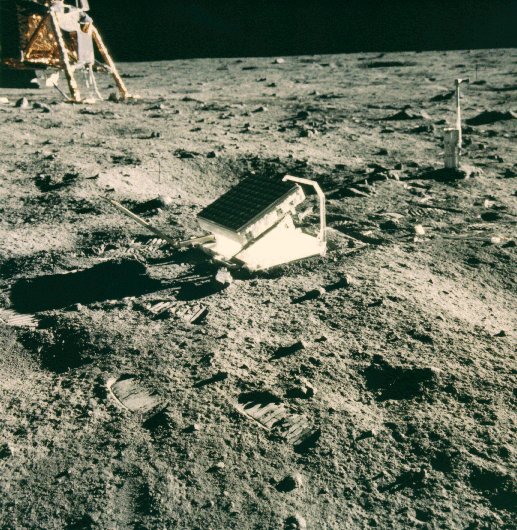Four Hundred Years Ago, Galileo’s Telescope Changed The World
August 25, 2009 by Admin
Filed under tech history
 August 25, 2009
August 25, 2009Despite the summer heat, the Senate of Venice assembled on this day in 1609 to view a remarkable scientific instrument. It was built by the well-known astronomer and philosopher from Pisa, Galileo Galilei, and could make distant objects appear closer when viewed through one end of its long pipe. It was a telescope.
Not that Galileo had invented the instrument. Credit for that is generally given to a Dutch stargazer who is almost forgotten today, Hans Lipperhay, who unveiled his basic telescope only the previous year, in 1608.
But Galileo, ever the practical perfectionist, had already improved upon the basic essentials and produced a variable-focus instrument that increased the size of the observed object by eight times.
Why he presented it first of all to the assembled Venetian senators is not clear. But perhaps the Venetians, who had business and commerce in their marrow, saw this instrument as a way to boost their glass lens industry. After all, Venice along with Florence, was the leading center for high-quality ground glass for spectacle lenses and magnifying glasses.
Certainly Galileo made money building and selling his telescope to eager customers, until his designs were overtaken in a relatively short time by more sophisticated types.
The telescope, of course, revolutionized astronomical observation and had a profound impact on overall scientific methodology, by allowing more exact mathematical calculations.
Blasphemous ‘Suncentricity’
It also brought into sharp focus the simmering dispute between those who followed the ancient belief of Greek and Egyptian proto-scientists that the Earth was the center of the universe, and that the planets revolved around it, and those who followed the Copernican theory that in fact our Earth is just one of a number of planets revolving around the sun.
Nicolaus Copernicus, the great Polish astronomer, had summarized his theories that the Earth revolved around the sun, instead of the other way around, some 60 years before Galileo intrigued the Venetian senators with his telescope.
Galileo, with his passion for exact observation and independent analysis, became ever more convinced through the use of his telescope that Copernicus was right. But it wasn’t long before this brought him into conflict with the Roman Catholic Church.
Some churchmen began attacking Galileo in 1610, arguing that God had made the Earth the center of the universe as a home for man.
By 1616, the matter had come to the official attention of the church, with the formal condemnation of “suncentricity” as “false and contrary to scripture.”
Galileo was warned to steer clear of such heresy, which he did for a number of years. But in 1632 he published a defense of his views. This landed him in front of that sinister body, the Inquisition. The Holy Office, as it preferred to be known, tried him, found him guilty of being “vehemently” suspect of heresy, and placed him under house arrest.
It also forced him to recant, which he did. Not very brave perhaps, but practical to the end, he may have thought it best to be a live astronomer than a dead ideologue.
It took the church 359 years to rehabilitate Galileo Galilei. Only in 1992 did the Vatican formally acknowledge that it had been wrong and Galileo right.
The astronomer died at his home outside Florence, still under house arrest, in 1642.
Laser Retro-reflector remains on moon
July 29, 2009 by Admin
Filed under tech history
 July 20, 2004: The most famous thing Neil Armstrong left on the moon 35 years ago is a footprint, a boot-shaped depression in the gray moondust. Millions of people have seen pictures of it, and one day, years from now, lunar tourists will flock to the Sea of Tranquility to see it in person. Peering over the rails … “hey, mom, is that the first one?”
July 20, 2004: The most famous thing Neil Armstrong left on the moon 35 years ago is a footprint, a boot-shaped depression in the gray moondust. Millions of people have seen pictures of it, and one day, years from now, lunar tourists will flock to the Sea of Tranquility to see it in person. Peering over the rails … “hey, mom, is that the first one?”
Will anyone notice, 100 feet away, something else Armstrong left behind?
 Ringed by footprints, sitting in the moondust, lies a 2-foot wide panel studded with 100 mirrors pointing at Earth: the “lunar laser ranging retroreflector array.” Apollo 11 astronauts Buzz Aldrin and Neil Armstrong put it there on July 21, 1969, about an hour before the end of their final moonwalk. Thirty-five years later, it’s the only Apollo science experiment still running.
Ringed by footprints, sitting in the moondust, lies a 2-foot wide panel studded with 100 mirrors pointing at Earth: the “lunar laser ranging retroreflector array.” Apollo 11 astronauts Buzz Aldrin and Neil Armstrong put it there on July 21, 1969, about an hour before the end of their final moonwalk. Thirty-five years later, it’s the only Apollo science experiment still running.
Right: The Apollo 11 lunar laser ranging retroreflector array. [More]
University of Maryland physics professor Carroll Alley was the project’s principal investigator during the Apollo years, and he follows its progress today. “Using these mirrors,” explains Alley, “we can ‘ping’ the moon with laser pulses and measure the Earth-moon distance very precisely. This is a wonderful way to learn about the moon’s orbit and to test theories of gravity.”
Here’s how it works: A laser pulse shoots out of a telescope on Earth, crosses the Earth-moon divide, and hits the array. Because the mirrors are “corner-cube reflectors,” they send the pulse straight back where it came from. “It’s like hitting a ball into the corner of a squash court,” explains Alley. Back on Earth, telescopes intercept the returning pulse–“usually just a single photon,” he marvels.
The round-trip travel time pinpoints the moon’s distance with staggering precision: better than a few centimeters out of 385,000 km, typically.
Targeting the mirrors and catching their faint reflections is a challenge, but astronomers have been doing it for 35 years. A key observing site is the McDonald Observatory in Texas where a 0.7 meter telescope regularly pings reflectors in the Sea of Tranquility (Apollo 11), at Fra Mauro (Apollo 14) and Hadley Rille (Apollo 15), and, sometimes, in the Sea of Serenity. There’s a set of mirrors there onboard the parked Soviet Lunokhud 2 moon rover–maybe thecoolest-looking robot ever built.
In this way, for decades, researchers have carefully traced the moon’s orbit, and they’ve learned some remarkable things, among them:
(1) The moon is spiraling away from Earth at a rate of 3.8 cm per year. Why? Earth’s ocean tides are responsible.
(2) The moon probably has a liquid core.
(3) The universal force of gravity is very stable. Newton’s gravitational constant Ghas changed less than 1 part in 100-billion since the laser experiments began.
 Physicists have also used the laser results to check Einstein’s theory of gravity, the general theory of relativity. So far, so good: Einstein’s equations predict the shape of the moon’s orbit as well as laser ranging can measure it. But Einstein, constantly tested, isn’t out of the woods yet. Some physicists (Alley is one of them) believe his general theory of relativity is flawed. If there is a flaw, lunar laser ranging might yet find it.
Physicists have also used the laser results to check Einstein’s theory of gravity, the general theory of relativity. So far, so good: Einstein’s equations predict the shape of the moon’s orbit as well as laser ranging can measure it. But Einstein, constantly tested, isn’t out of the woods yet. Some physicists (Alley is one of them) believe his general theory of relativity is flawed. If there is a flaw, lunar laser ranging might yet find it.
Right: Lunar laser ranging at the McDonald Observatory. [More]
NASA and the National Science Foundation are funding a new facility in New Mexico, the Apache Point Observatory Lunar Laser-ranging Operation or, appropriately, “APOLLO” for short. Using a 3.5-meter telescope with good atmospheric “seeing,” researchers there will examine the moon’s orbit withmillimeter precision, 10 times better than before.
“Who knows what they’ll discover?” wonders Alley.
More and better data could reveal strange fluctuations in gravity, amendments to Einstein, the “sloshing” of the moon’s core. Time will tell … and there’s plenty of time. Lunar mirrors require no power source. They haven’t been covered with moondust or pelted by meteoroids, as early Apollo planners feared. Lunar ranging should continue for decades, perhaps for centuries.
Picture this: Tourists in the Sea of Tranquility, looking up at Earth. Half of the planet is dark, including New Mexico where a pinprick of light appears. A laser.
“Hey, mom,” stepping over a footprint, “what’s that star?”
